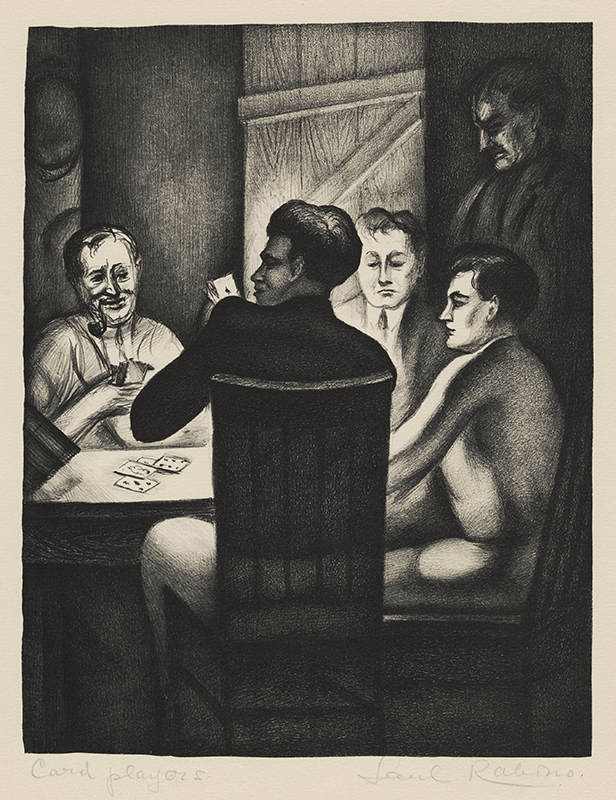Card Players is a lithograph created about 1935 by Russian-born American artist, Saul Jacob Rabino. This lithograph is pencil signed and titled and was published by the WPA. Card Players is listed among forty titles on the WPA allocation cards for Saul Rabino. It is possible that this impression was printed by Ray Bertrand in San Francisco using the transfer paper process. It was printed on cream wove paper in an edition of about 28 impressions and the image size is 11-7/8 x 9-1/8 inches. This image has also been entitled Fun at Home.
Rabino produced a number of lithographs on the theme of entertainment: card players, chess players, opera and theatre attendees, music, and musicians. Card Players is set in a small room and the interior and players are dramatically illuminated from an overhead light source. Aside from their faces, the figures dissolve from realism to modernism as their bodies morph into rounded shapes and their legs and feet disappear. Each character has a minimally drawn unique face except that of man smoking a pipe at left. Humor is offered in the “poker faces” of the three men at right, the protectively raised shoulder and arm of the central figure as he shields his hand, and the feminine arms and hands projecting outward and over the table from the left edge of the image.
Saul Jacob Rabino, painter, muralist, printmaker and sculptor, was born Saul Rabinowitz in Odessa, Russia on 2 July 1892. He studied at the Russian Imperial Art School and later in Paris at the École des Arts Decoratifs. He immigrated to the United States in 1922 where his name was shortened at the immigration center. Rabino moved permanently to Los Angeles, California in 1932 where he found employment on the WPA Federal Art Project. Under the auspices of the WPA, Rabino painted the mural Moses—Hebrew Prophets in 1937 for the Jewish Home for the Aged in the Boyle Heights neighborhood of Los Angeles and under the WPA Graphic Art Division he created about forty lithographs on the subjects of WPA workers, chess players, music, entertainment, Jewish life, and the unemployed. During the 1940s, he drew allegorical images of war and the plight of Jews in Eastern Europe and he also portrayed the scholars and religious leaders of the Jewish community. His work was included in the 1939 New York World’s Fair exhibit, American Art Today. Rabino was also featured in exhibits at the Los Angeles Museum of Art, the Laguna Beach Art Museum and, in winter 1942, the solo exhibition Prints and Drawings by Saul Rabino was mounted at the Legion of Honor in San Francisco. The work of Saul Jacob Rabino is represented in the permanent collections of the Baltimore Museum of Art, Maryland; the Weisman Art Museum, Minneapolis, Minnesota; the Jewish Museum, New York; the Seattle Art Museum, Washington; and the National Gallery of Art and the Smithsonian American Art Museum, Washington, D.C.
Saul Jacob Rabino died in Los Angeles, California on 29 October 1969.



